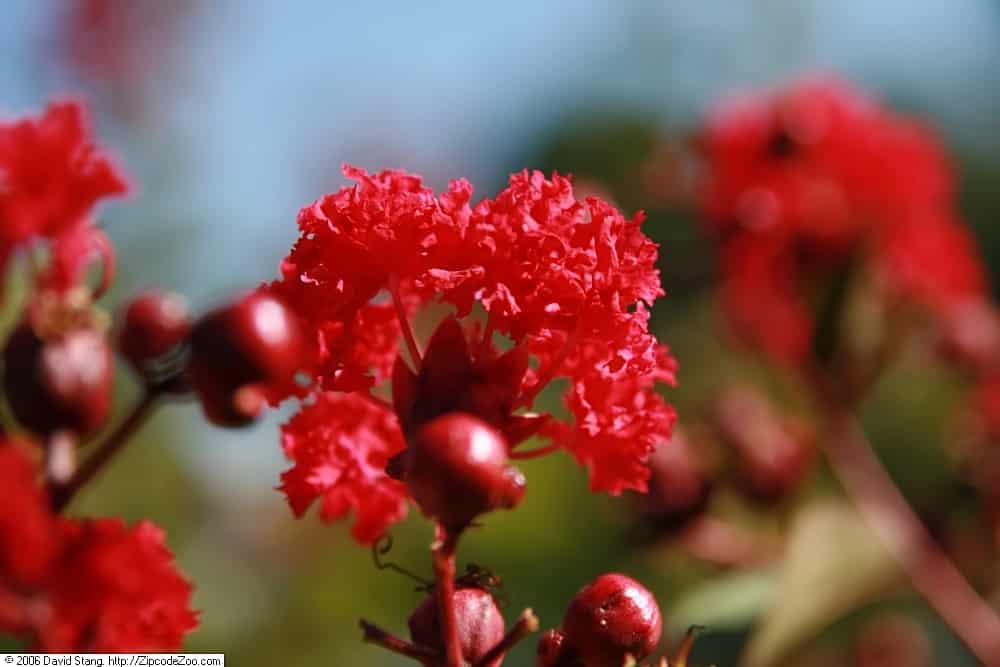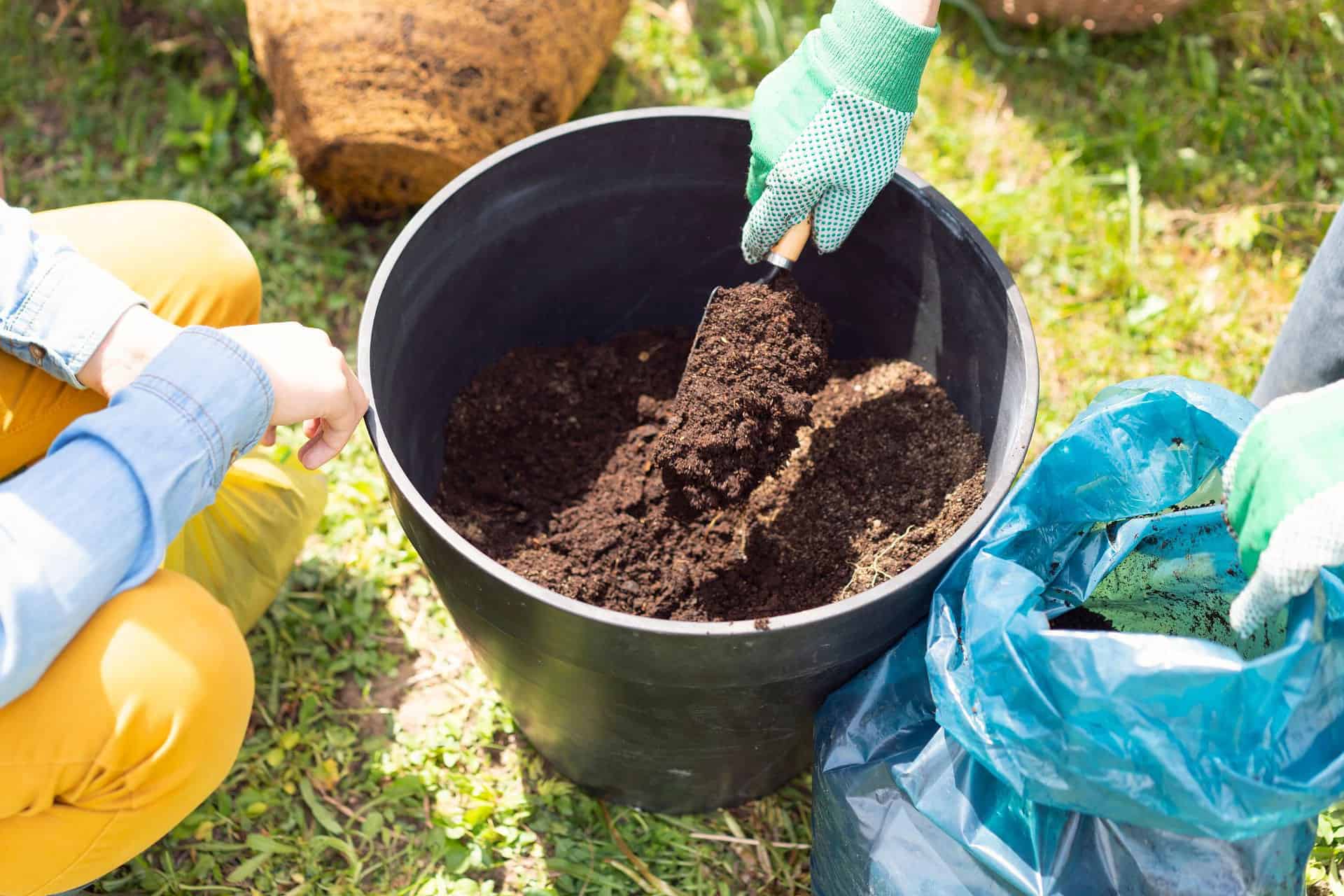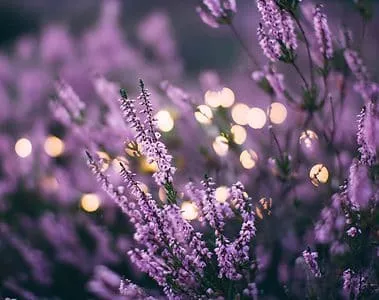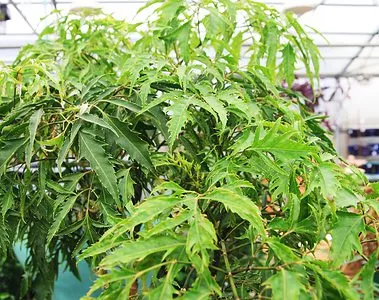No products in the cart.
If you want to add vibrant color to your landscape, nothing brightens the garden more than the Dynamite Crape Myrtle tree.
You see a display of blazing red flowers with orange-red foliage lasting from summer to fall. When planted in fall, the Dynamite Crape Myrtle establishes itself fast before winter.
Today we will share some care tips for this pretty amazing tree.
Plant Name: Lagerstroemia indica “Whit II”
Other Name: Crepe Myrtle, Loosestrife, Lilac of the South
Plant Type: Deciduous Trees
Native Areas: Asia
Light Requirement: Full Sunlight
Watering: Moderate
Fertilizer: Slow Release Fertilizer
Toxicity: Family-friendly but toxic to animals
Temperature: Can tolerate temperatures down to -10°
Propagation: Semi-hardwood Cuttings
Growth: 20 feet tall and up to 20 feet wide
Soil Type: Well-Drained Soil
USDA Hardiness Zones: 6-10
More About Dynamite Crape Myrtles
The Dynamite Crape Myrtle produces long-lasting clusters of deep red flowers. Each of the clusters ranges from eight to 16 inches long.
Dynamite Crape Myrtle grows with an upright form producing dark green foliage in early spring and turning bright green in summer.
In the fall, the leaves turn orange-red, and the trees exfoliate the gray-brown bark to expose light brown inner bark.
The Dynamite Crape Myrtle can adapt to different soils, and it is very drought tolerant and can resist powdery mildew well. This tree is winter hardy to USDA Zone 7.
While the tree is native to Asia, it is deciduous, and dense branches make for an exceptional ornamental display in the landscape.
The Crape Myrtle is fast growing and wide spreading to grow as small trees or shrubs to become the focal point in your landscape.
The Norfolk Botanical Garden in the U.S. showcases 250 Lagerstroemia plants with 82 diverse species and cultivars. Discover them mainly in the Flowering Arboretum, where a vibrant crape myrtle planting invites visitors to appreciate and compare their distinct qualities.
Dynamite Crape Myrtle Care Guide

When caring for the Dynamite Crape Myrtle tree, you can grow it as a specimen plant, privacy screen, or a standalone tree in your garden. Here you can find all the essential care information to have a healthy outdoor plant.
Planting Lagerstroemia Indica Whit ii
Before planting your Dynamite Crape Myrtle, it helps to remove all the debris, weeds, and rocks from your planting site.
Dig a hole twice as wide and at the same depth as the root system. Space your tree at least 15 feet away from other plants or buildings.
Remove the root ball from the container and cut through any circling roots using pruning shears to prevent this growth from continuing.
Then pull the roots outwards by massaging the root ball and gently spreading the roots.
Place the Crape Myrtle in the center of the hole and remove or add soil underneath to position the root balls top level with the ground.
Fill the hole halfway with the soil and tamp it around the roots to remove the air pockets.
Fill the hole with water and wait for it to absorb into the soil.
Fill the remaining space and tamp down again, trying not to overfill the hole. Keep the root ball at the same height as grown in the container.
Next, make a four-inch mound using the soil around the tree and tamp it in place.
Fill the reservoir with water and wait until the water soaks entirely into the ground.
Now you can spread some pine bark mulch over the planting site and the surrounding soil, keeping it away from the main trunk.
The Best Soil For Dynamite Crape Myrtle Trees

The Lagerstroemia indica Whit ii has a good tolerance for most soil types. But these trees prefer acidic to well-drained soil. Hence the soil pH should be around 5-6.5.
Lighting Needs For Those Cherry Red Flowers

The Crape Myrtles need a spot in full sun for those gorgeous blooms and their health. In addition, standing in full sun helps develop the red flowers. It can handle shade, but too much will lead to fewer blooms.
Watering Dynamite Crape Myrtle Trees
While the Dynamite Crape Myrtles are cold, hardy, and drought tolerant, it still thrives in moist soil. For young trees, we recommend you water twice a week deeply for the first growing season.
Doing this helps the Dynamite Crape Myrtle grow to become established. Then you can reduce your watering to once a week. Next, we recommend you stick your finger into the surrounding soil to feel if the soil is moist.
Pollination of Crape Myrtle Trees

While the red blooms add color to the landscape, they also benefit the local ecosystem. Standing in full sun and the tree blooms can last summer long, attracting pollinators to the yard. Another benefit is that the tree does not produce edible harvests, causing any berries to fall to the ground, becoming a problem.
Fertilizing Dynamite Crape Myrtle Tree
When fertilizing the Dynamite Crape Myrtle, we recommend using a multi-purpose slow-release fertilizer in early spring. We do not recommend overfeeding your Myrtle tree as it will support the leaf growth, but you will have fewer blooms. For Dynamite Crape, less is better than too much fertilizer.

Pruning Dynamite Crape Myrtles
As the Dynamite Crape Myrtle has several trunks, you can leave them intact. But you can remove suckers, those extra limbs that grow from the ground.
The Dyname Crape blooms from the new wood, and pruning is done in late winter. You can remove the excess limbs or dead branches from young trees to diseased ones.
You can use pruning to limit growth, but over-pruning your tree can be harmful. So prune sparingly to keep your tree healthy.
Propagating a Specimen Tree
When you have patented Crape Myrtle trees, propagation is prohibited, yet if the patent expires of cultivars marketed since the 1990s, you can propagate them.
The best method to propagate the Dynamite Crape Myrtles is using semi-hardwood cuttings taken from the new growth during the growing season.
The best is to take a cutting with four nodes and a few leaves. Then, place the cutting in well-drained soil and keep it in a shaded area and moist. Finally, you can enclose the pot with a clear plastic bag.
The Difference Between Red Rocket and Dynamite Crape Myrtle
You can find two popular trees in the Crape Myrtle varieties, the Dynamite Crape Myrtle and Red Rock Crape Myrtle. But which one should you choose and what is the difference?
When comparing the two trees, the Red Crape has more extended flower clusters corresponded to the shorter ones in the Dynamite Crape Myrtles.
This is because the Red Rocket grows faster, with a growth rate of 5 feet yearly, compared to the 3 feet of the Dynamite Crape.
Still, you can grow both these specimen trees as standalone trees or in groups for the striking red blooms displayed.
Dynamite Crape Myrtle Common Diseases and Pests
While the Dynamite Crape Myrtle tree has exceptional pest and disease resistance, it can still be bothered by many pests.
Some diseases to look out for on your tree are:
Powdery Mildew
Cercospora Leaf Spot
Sooty Mold
Root Rot
Furthermore, while the Dynamite Crape has good resistance against insects, it can be bothered by aphids. These insects can spread viruses sucking out the nutrients of your tree. So to manage an infestation, it helps to use an insecticidal treatment.
Frequently Asked Questions
We feel the Dynamite Crape Myrtle is one of the prettiest specimen trees. When in bloom, the red flowers stand out in the landscape, while the fall foliage in orange-red makes for a beautiful display.
The Crepe Myrtle tree can live up to 100 years and more.
The only messy thing about the Crepe Myrtle is the flowers that end up on the ground, and you will need to remove them.
If you notice your Crepe Myrtle weeping, it can result from aphids on the tree. These small yellow-green insects feed on the leaves by sucking the sap out. The liquid will start to drip, but the fluid passes through the pests as they feed.
The Dynamite Crape Myrtle you can find at a local garden center or nursery, but you need not leave home. Plantly has a collection of Crepe Myrtles here to buy.
Whether you want to buy, sell, or simply reach out to other plant enthusiasts, Plantly is the right place to be!
-
$5.99Sold By: BubbleBlooms
In stock
Asparagus fern, Asparagus setaceus, limited, in a 2 inch pot super cute
Only 922 available and it’s in 7 people’s basketRated 4.81 out of 5 based on 279 customer ratings03Sold By: BubbleBlooms -
$8.00Sold By: Helios Plants
In stock
852 Citrandarin- 5 seeds – Cold hardy to 5F!
Rated 4.73 out of 5 based on 120 customer ratings00Sold By: Helios Plants -
$4.59Sold By: Cacti and Exotica
In stock
Rhipsalis Paradoxa 2″ Pot
Only 9 available and it’s in 1 people’s basketRated 4.98 out of 5 based on 59 customer ratings00Sold By: Cacti and Exotica -
$29.99Sold By: Rooted & Grounded Nursery
In stock (can be backordered)
Yellow Live Plant Bougainvillea Vine 6″ Pot Trellis
Sold By: Rooted & Grounded Nursery






